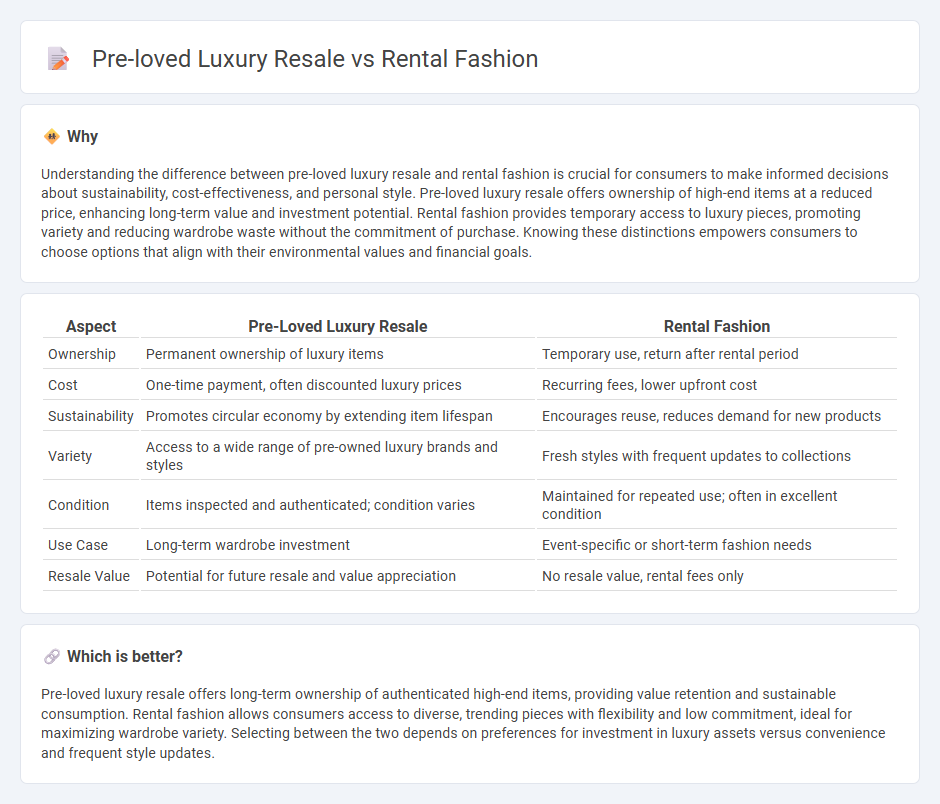
Pre-loved luxury resale offers sustainable access to high-end fashion by allowing consumers to purchase authentic designer items at reduced prices, promoting circular economy principles. Rental fashion provides a flexible alternative for wearing luxury pieces temporarily, reducing waste and revitalizing wardrobes without long-term commitment. Explore the benefits of these evolving commerce models and how they redefine luxury consumption today.
Why it is important
Understanding the difference between pre-loved luxury resale and rental fashion is crucial for consumers to make informed decisions about sustainability, cost-effectiveness, and personal style. Pre-loved luxury resale offers ownership of high-end items at a reduced price, enhancing long-term value and investment potential. Rental fashion provides temporary access to luxury pieces, promoting variety and reducing wardrobe waste without the commitment of purchase. Knowing these distinctions empowers consumers to choose options that align with their environmental values and financial goals.
Comparison Table
| Aspect | Pre-Loved Luxury Resale | Rental Fashion |
|---|---|---|
| Ownership | Permanent ownership of luxury items | Temporary use, return after rental period |
| Cost | One-time payment, often discounted luxury prices | Recurring fees, lower upfront cost |
| Sustainability | Promotes circular economy by extending item lifespan | Encourages reuse, reduces demand for new products |
| Variety | Access to a wide range of pre-owned luxury brands and styles | Fresh styles with frequent updates to collections |
| Condition | Items inspected and authenticated; condition varies | Maintained for repeated use; often in excellent condition |
| Use Case | Long-term wardrobe investment | Event-specific or short-term fashion needs |
| Resale Value | Potential for future resale and value appreciation | No resale value, rental fees only |
Which is better?
Pre-loved luxury resale offers long-term ownership of authenticated high-end items, providing value retention and sustainable consumption. Rental fashion allows consumers access to diverse, trending pieces with flexibility and low commitment, ideal for maximizing wardrobe variety. Selecting between the two depends on preferences for investment in luxury assets versus convenience and frequent style updates.
Connection
Pre-loved luxury resale and rental fashion both capitalize on the growing consumer demand for sustainable and cost-effective access to high-end brands, reducing environmental impact by extending product life cycles. These commerce models leverage digital platforms to offer authenticated designer items, enhancing trust and expanding market reach. The integration of resale and rental services creates a circular economy that maximizes value extraction from luxury goods while promoting conscious consumption trends.
Key Terms
Circular Economy
Rental fashion and pre-loved luxury resale contribute significantly to the Circular Economy by extending product lifecycles and reducing textile waste. Rental services promote temporary use, minimizing the demand for new apparel production, while pre-loved luxury resale offers high-value items a second life, preserving their craftsmanship. Explore how these sustainable consumption models drive eco-friendly practices and reshape the future of fashion.
Consumer Behavior
Consumer behavior in rental fashion reveals a growing preference for flexible access to trendy apparel without ownership, driven by younger, environmentally-conscious demographics prioritizing sustainability and variety. In contrast, pre-loved luxury resale appeals to value-seeking consumers who emphasize authenticity, investment potential, and brand prestige, often targeting affluent buyers interested in long-term ownership at reduced prices. Explore detailed insights into how these distinct consumer motivations shape the evolving fashion market landscape.
Sustainability
Rental fashion significantly reduces textile waste by encouraging multiple uses of the same garment, minimizing environmental impact through lowered production demands. Pre-loved luxury resale promotes sustainability by extending the lifecycle of high-quality items, preserving resources embedded in original manufacturing processes and reducing landfill contributions. Explore how these innovative models transform sustainable fashion consumption.
Source and External Links
The Rise of Rental Fashion: Why Borrowing is the New Buying - Rental fashion is gaining popularity as a cost-effective, sustainable alternative to buying, emphasizing access over ownership and supporting eco-friendly consumer values around the world.
7 Clothing Rental Brands to Try - Commons - Clothing rental services offer a way to experiment with styles sustainably, featuring brands like Rent the Runway and ModLux.Rent that provide subscription models and event-specific rentals without long-term commitment.
Taelor.Style: Dress nice with GQ Best Men's Clothing Rental - Taelor offers menswear rental with personalized styling by experts, access to over 300 brands, and an easy swap system designed to save time and promote sustainable fashion.
 dowidth.com
dowidth.com